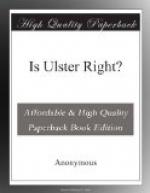“I do solemnly and sincerely declare that I do believe in my conscience that the person pretended to be Prince of Wales during the life of the late King James and since his decease taking upon himself the style and title of King of England by the name of James III hath not any right or title whatever to the crown of this realm.”
A modern Roman Catholic writer has thus described the oath:—
“By the Oath of Abjuration the priest was ordered to swear that the sacrifice of the mass and the invocation of the Blessed Virgin and the saints were damnable and idolatrous. In other words, the priest was ordered to apostatize, or fly for his life.”
And even if Roman Catholics took the oath of allegiance, the old difficulty arose as to the papal right to depose princes and to order their subjects to rebel. So late as 1768, when a declaration was drawn up which it was hoped the leaders of the Roman Catholic party would sign, so that the penal laws might be finally done away with, the Papal Nuncio vetoed the proposal because the declaration contained a reprobation of the doctrines that faith need not be kept with heretics and that if the Pope banned a sovereign his subjects might depose and slay him. It is but fair to add, however, that a large number of Roman Catholics did sign the declaration; and the penal laws (which had been relaxed from time to time when it was seen that the Irish took no part in the Stuart rebellions of 1715 and 1745) were soon afterwards practically abolished.
Then it must be borne in mind that the Irish penal laws, although to some extent modelled on the legislation of Louis XIV against the Huguenots, were absolutely insignificant compared with those which were in force at the time in every Roman Catholic country in Europe. Galling though the Irish laws were, they never went so far as to make the mere holding of heretical opinions criminal. Thus no one in Ireland was ever put to death for believing in transubstantiation; whereas in one diocese of Portugal 20,000 people were sent to the stake for denying it. As every one who has visited the Madrid picture gallery will recollect, it was still the custom in the eighteenth century for the King of Spain to preside in state at the burning of heretics; and it was not until that century was




